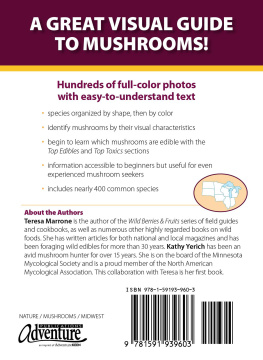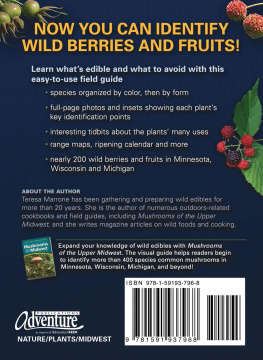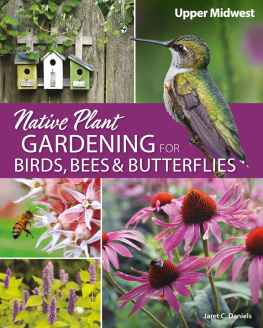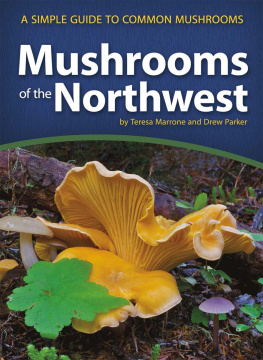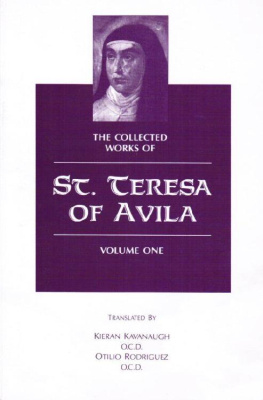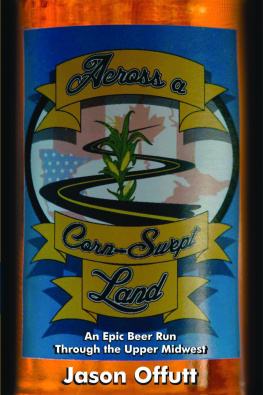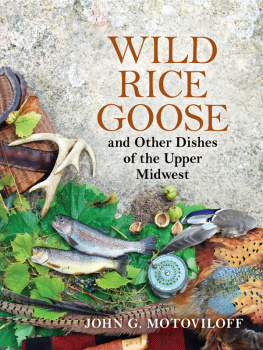Teresa Marrone - Mushrooms of the Upper Midwest
Here you can read online Teresa Marrone - Mushrooms of the Upper Midwest full text of the book (entire story) in english for free. Download pdf and epub, get meaning, cover and reviews about this ebook. year: 2020, publisher: Adventure Publications, genre: Romance novel. Description of the work, (preface) as well as reviews are available. Best literature library LitArk.com created for fans of good reading and offers a wide selection of genres:
Romance novel
Science fiction
Adventure
Detective
Science
History
Home and family
Prose
Art
Politics
Computer
Non-fiction
Religion
Business
Children
Humor
Choose a favorite category and find really read worthwhile books. Enjoy immersion in the world of imagination, feel the emotions of the characters or learn something new for yourself, make an fascinating discovery.
- Book:Mushrooms of the Upper Midwest
- Author:
- Publisher:Adventure Publications
- Genre:
- Year:2020
- Rating:5 / 5
- Favourites:Add to favourites
- Your mark:
- 100
- 1
- 2
- 3
- 4
- 5
Mushrooms of the Upper Midwest: summary, description and annotation
We offer to read an annotation, description, summary or preface (depends on what the author of the book "Mushrooms of the Upper Midwest" wrote himself). If you haven't found the necessary information about the book — write in the comments, we will try to find it.
Mushrooms of the Upper Midwest — read online for free the complete book (whole text) full work
Below is the text of the book, divided by pages. System saving the place of the last page read, allows you to conveniently read the book "Mushrooms of the Upper Midwest" online for free, without having to search again every time where you left off. Put a bookmark, and you can go to the page where you finished reading at any time.
Font size:
Interval:
Bookmark:


Acknowledgments
Special thanks to Ron Spinosa for his advice and assistance throughout the writing of this book and also for his review of the final manuscript. (See .)
Cover, book design and illustrations by Jonathan Norberg
Page layout by Teresa Marrone
Edited by Brett Ortler
Cover photo: Tylopilus felleus by Teresa Marrone
All photos by Teresa Marrone and Kathy Yerich unless noted (see for additional photos).
The authors would like to gratefully acknowledge fellow mycophile Walt Sturgeon (co-author of Mushrooms of the Northeast , with Teresa Marrone), who provided valuable information on various mushrooms, assisted with changes in this second edition, and took a number of photos that appear in this book.
PHOTOS BY WALT STURGEON: , Scaly Chanterelle.
IMAGES USED UNDER LICENSE FROM , top left : N. F. Photography.
10 9 8 7 6 5 4 3 2 1
Mushrooms of the Upper Midwest
First Edition 2014, Second Edition 2020
Copyright 2014 and 2020 by Teresa Marrone and Kathy Yerich
Published by Adventure Publications, an imprint of AdventureKEEN
330 Garfield Street South, Cambridge, Minnesota 55008
(800) 678-7006
www.adventurepublications.net
All rights reserved
Printed in China
ISBN 978-1-59193-960-3 (pbk.)
Table of Contents
About This Book
This book was written with the beginning mushroom enthusiast in mind. It is a pocket-sized field guide featuring hundreds of the most common species in the Upper Midwest, with clear pictures and additional comparisons for each species. Many beginner books feature just the top eminently edible and deadly toxic varieties, while leaving out the hundredsmaybe thousandsof other species that grow in the area. Some books are generalized and may present descriptions and photos of mushrooms that dont grow in our area, the Upper Midwest. Given the sheer number of mushroom species in the Upper Midwest alone, one book cannot completely cover every species you are likely to find especially not one youd care to carry into the field!

This book includes North Dakota, South Dakota, Minnesota, Iowa, Wisconsin, Michigan, Illinois and Indiana
Our hope is that this book will both spark your interest about mushrooms and provide you with the means to learn more. A list of useful resources is included at the end of this book, as is a list of some mushroom terms you may encounter in those and other resources. First and foremost, we have arranged the entries in this book by what they look like, or their morphology . Many of the genus and species names that originally placed a mushroom in a certain family were assigned by experts because of the mushrooms physical appearance, and many other books arrange species based on their names or the scientific classification. But it is hard to look up a mushroom in a book by its name when you dont have a clue what it is yet.
Many misidentifications start with a hopeful guess that guides you to a book entry that, while incorrect, may have numerous features that seem to match the specimen you have found. The temptation is strong to force the description to fit what you have in hand. This can be a dangerous path to travel when attempting to identify wild mushrooms; a mistaken identification may prove harmful or, in the worst case, even fatal if a misidentified mushroom is eaten because the reader attempted to make the specimen fit the description given in a book. For this reason, we strongly advise that novice mushroom enthusiasts consult multiple reliable references or, better still, a local authority who can verify the identity of the mushroom in question before it is eaten.
Remember, too, that when attempting to compare features of mushrooms in various references or when discussing them with other enthusiasts, the scientific name (which is always in Latin) must be used. The colorful, sometimes descriptive and often humorous common names of mushrooms are fun but can vary by region and are not a truly reliable way to label a species. Using the Latin genus and species name, referred to as taxonomy , is the standard and most respected way of referring to a specific variety. However, without a microscope it is often impossible to determine the difference between species with similar appearances. Even some scientists have been overheard in the field referring to a drab specimen simply as an LBM (little brown mushroom).
To make things more complicated, as more species are discovered and scientists have the ability to study them in more depth with microscopic examination, mating studies and DNA sequencing, authorities are finding that many of the mushrooms that were given their Latin name hundreds of years ago may belong to a different genus than that to which they were originally assigned. In fact, some of the names remain in constant flux, creating so much confusion that at any one time a specific mushroom could be referred to by multiple names, depending on your source. Again, weve attempted to list as many species as possible while keeping this a pocket-sized book. Weve also used single quotes around names (such as Russula densifolia ) used for species which appear in, say, Europe but not in North America; this means that specimens found in North America are very similar but not exactly the same as their European counterparts, but a new name has not yet been published.
There is also a complete index starting referencing both common and Latin names, and youll see that we have included both on the ID pages.
We have been greatly aided in our decades-long studies by numerous people who generously shared their expertise with us over the years, and particularly those who helped us as we developed this book. Ron Spinosa has been a wonderful mentor and friend during the work on this project, and his assistance helped make this book possible. Wed also like to thank Lee Moellerman for coordinating the Minnesota Mycological Society field forays, as well as the many MMS members who shared their knowledge in the field and also helped us locate species to photograph on various forays.
In writing this book we have also consulted many excellent books and other sources; a list of the best is included in .
What Is a Mushroom?
Mycology is the study of mushrooms. In very general terms, mushrooms are the fruiting body of an organism from the Kingdom Fungi. Indeed, many references refer to the aboveground portion of a fungal organism as a fruitbody , although the word mushroom is far more common in everyday use. Mushrooms are not plants, because unlike plants they do not use sunlight to photosynthesize their food. More like animals, they use enzymes to break down what they consume. In their role as decomposers of organic material, fungi are essential to life on earth, because without them, the world would be buried in its own debris. In the forest, fungi break down dead or dying organic matter and render it into soil, making it usable for new growth.
The mycelium or roots of the organism may spread for miles underground, or inhabit an entire tree. The part that we see (and harvest, if we so choose) is comparable to the fruit we pick from a tree; the treeand the myceliumremains to bear fruit the following season. Like fruits, mushrooms can also assist in reproduction; just as an apple produces seeds that can grow into a new tree, mushrooms produce microscopic spores that are dispersed by wind, insects or other vectors, allowing the larger organism to spread into new areas. Of course, that is a very simple description. There are thousands of species of fungi with complicated life cycles and growth patterns. Learning some basic mycological terms and understanding how mushrooms grow and reproduce will help you understand some of what youll encounter, but because of the staggering amount of diversity youll run into, it is more important to learn how to decipher what you are seeing.
Font size:
Interval:
Bookmark:
Similar books «Mushrooms of the Upper Midwest»
Look at similar books to Mushrooms of the Upper Midwest. We have selected literature similar in name and meaning in the hope of providing readers with more options to find new, interesting, not yet read works.
Discussion, reviews of the book Mushrooms of the Upper Midwest and just readers' own opinions. Leave your comments, write what you think about the work, its meaning or the main characters. Specify what exactly you liked and what you didn't like, and why you think so.

